Ijraset Journal For Research in Applied Science and Engineering Technology
- Home / Ijraset
- On This Page
- Abstract
- Introduction
- Conclusion
- References
- Copyright
Planning, Scheduling and Cost Estimation Of Villa Project Using Microsoft Project
Authors: Prajna Ganesh Gunaga, Geena George
DOI Link: https://doi.org/10.22214/ijraset.2022.46885
Certificate: View Certificate
Abstract
Many construction projects experience schedule and expense overruns which results in poor planning, scheduling, and execution, which causes number of problems such as delays in the provision of facilities, development, a decline in construction quality, and an increase in project cost. A little thought reveals that the amount of time needed to accomplish the job is inversely related to the availability of labor. When the number of workers is raised, the project\'s completion time is shortened; conversely, when the number of workers is reduced, the project\'s completion time is lengthened. The present study deals with the manpower, planning, scheduling and resource optimization of “Construction of a Villa Project at Chaitanya Sharan, Bengaluru”, a two storied (G+2) building of 26 units whose construction is complete at Gunjur, Bengaluru, Karnataka. This study uses Microsoft Project 2013 to schedule various building activities, allocating resources, and level those resources in order to examine project management strategies. In essence, it relates to finding a solution to the project\'s excessive resource allocation. This project illustrates how resource levelling may be accomplished with Microsoft Project and what impact it might have on overall project duration.
Introduction
I. INTRODUCTION
The science and art of planning, organising, leading, and controlling the work of organisation members while utilising all organisational resources to achieve specified organisational goals is referred to as management. Construction projects must be finished within the allotted time frame and comprise a variety of tasks carried out by both expert and unskilled labour. Due to poor project planning and poor completion management, the civil engineering industry is currently dealing with a number of problems, the majority of which are time and expense related.
Based on the limitations of the resources, this strategy modifies the start and end dates. When necessary resources are overcrowded or only available at specific times or in specific quantities, it is employed. Resource smoothing is a strategy for modifying the schedule model's activities. It makes sure that the project's resource requirements don't go over or surpass the pre- established resource restrictions. The project is estimated in order to find out the overall cost required to complete it. In order to comprehend the cash flow, it is important to be aware of the financing requirements at each stage of construction.
II. METHODOLOGY
Chaitanya Sharan Projects Pvt. Ltd.'s construction is the case study project. The project's construction is now completed. The Chaitanya Sharan project entails the development of 26 luxurious villas (G+2).
The project's estimated completion date was 12/04/2022, and work on it began on 10/06/2020. The project consists of 97 tasks in total. About 1.5 years have been allotted for the project's completion (inclusive of rainy season). Along with the built-in community hall, there are 26 villas.
The following are the main steps in our work using the Microsoft project software:
Phase I: Planning (data collection, quantity surveying), Scheduling
Phase II: Resource Allocation, Resource Levelling
A. Planning
- Data Gathering: Drawings are gathered as part of the data collection process. It is important to gather all architectural drawings as well as a summary of all the actions involved.
- Quantity Surveying: Calculating quantities from the obtained drawings for each and every item is a part of quantity surveying.
B. Scheduling
Following the collection of drawings and the creation of an activity list, the quantity for each and every activity has been determined. The next step is to schedule the tasks using the MS-Project software. Following is the scheduling process: Making a new project plan, assigning a calendar, setting project information, entering task, establishing WBS, scheduling activities, resource allocation and leveling in MS-Project are all steps in the process.
C. Developing A Fresh Project Plan
The project schedule for this study is known as Chaitanya Sharan, and it runs from 8:00 AM to 17:00 PM with an hour for lunch between 12:00 PM and 1:00 PM. The calendar has 48 hours of labour each week, or 8 hours of work per day, 6 days per week, and 30 working days per day. Figure 1 shows the Standard Calendar considered for this Villa Project.
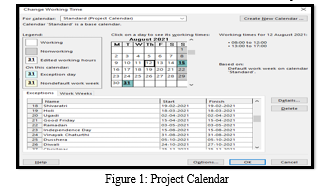
D. Establishing A Work Breakdown Structure
A WBS shows the hierarchy of a project's component parts. Using the work breakdown structure, a project called home structures is created. This creates various other activities in sequence inside of it. Project breakdown structures such as excavation and earthwork, foundation, superstructure, reinforcement, concreting, brick work including doors and windows frame, lintel work, interior plaster, waterproofing work, external plaster, finishing work, painting and service work are then produced inside this home structures. Figure 2 shows the WBS for the entire project.
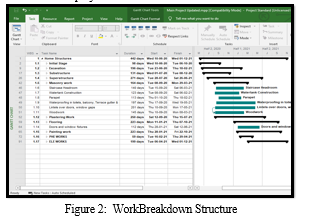
E. Gantt Chart
A Gantt chart is used to create the project schedule for identifying the order of construction. These activities were given resources (manpower). Resource levelling has been done after considering the actual resources that are accessible on the construction site.
F. Resource Optimization
- Resource Allocation: The accuracy of a project's timetable can be improved by adding resources. The Microsoft Project software determines whether resources are over allocated or not when they are assigned, and if they are, it will indicate this in the task sheet and resource sheet.
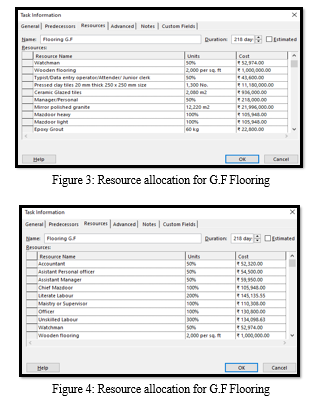
Base calendar is only available for resources of the work type. The estimated cost for all the activities and for the entire project is then determined. This job is completed utilising Analysis of Rate CPWD. Figure 3 and Figure 4 shows the resource allocation for Ground floor flooring. Similiarly, for all the other activities the resources are allocated.
2. Over Allocation of Resources: When a resource is assigned to a task and spends more time than allowed by its work schedule on a single task or a group of tasks that are due at the same time. After allocating resources to various tasks, we notice that some of the resources have been overused, which is shown by the colour red. Figure 3.25 and Figure 3.26 shows that the resources that are over allocated are highlighted in red in the resource sheet of MS Project.
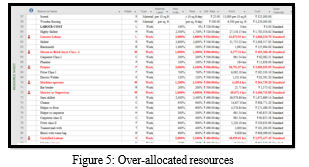
3. Over-allocated resource Histogram: The scheduled dates for which resources are over allocated are shown in this histogram. Levelling of resources is crucial for efficient resource use. The over-allocated resources are Assistant Personal Officer, Painter, Tractor Trolley, Supervisor, Machine Operator, Manager Personal, Unskilled labour, Mistry/Supervisor, Mason, Lietrate Labour.
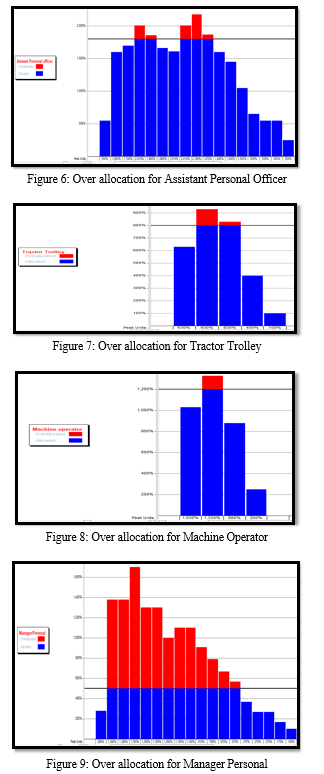
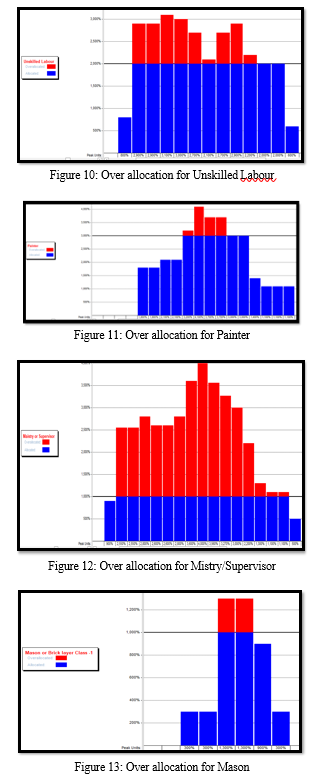
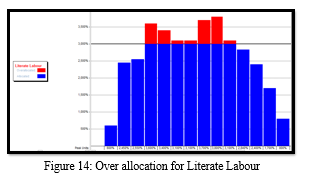
4. Resource Levelling: Levelling is done to balance the activity operation to which the over allocated resources were assigned by levelling the over allocated resources. As demonstrated in the following figures, we introduced the Automatic Levelling option in MSP 2013 which levelled all of the over allocated resources. As a result, after levelling, the price and duration changed. Levelling is carried out with the changes in duration as this there is no time constraint. Figure 3.36 shows how the resource levelling is done.
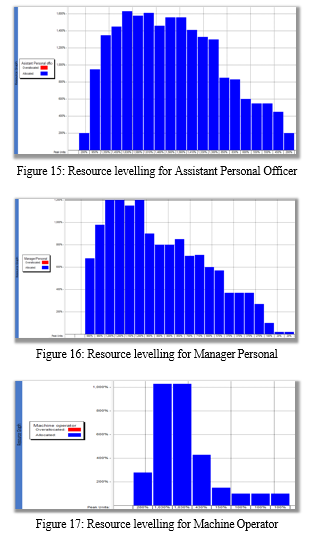
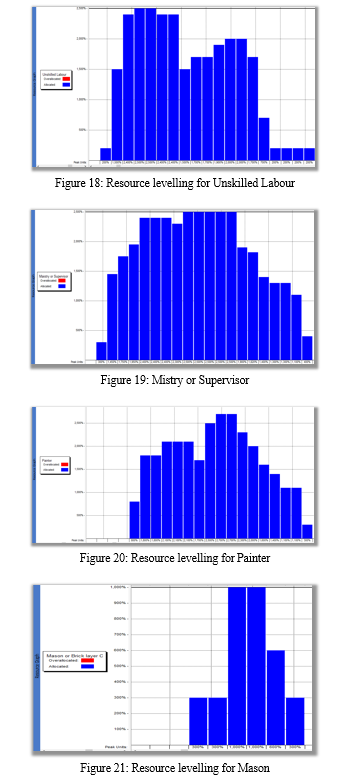
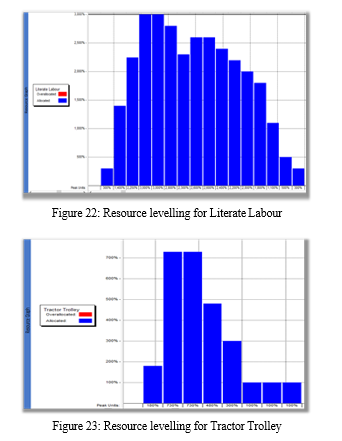
The process of assigning and managing resources in a way that helps the organisation achieve its planned goals is known as resource allocation. Resources typically refer to labour, money, and material.
5. Resource Calculation: Once the levelling is done, the duration of the project is also changed. Earlier the total duration required to complete the whole project was 442 days and after levelling it has been increased to 548 days. The Software automatically calculates the cost of resources for the entire project. The cost is increased after levelling the resources.
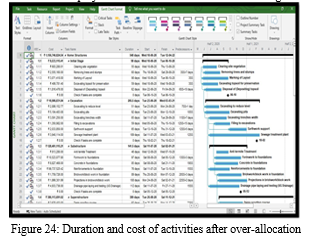
III. RESULTS
A. Network Diagram
It is a graphic representation of the many activities and how they relate to one another. The network diagram here displays the project's tasks in the sequential sequence in which they will be completed. The network diagram enables the construction and connection of the tasks and their intended execution visibly. A network diagram may include tasks, deliverables, milestones, or subprojects. Also displayed is the critical path. CPM network will be given by MS Project. Activities that are highlighted in pink are those that are critical; other activities are not.
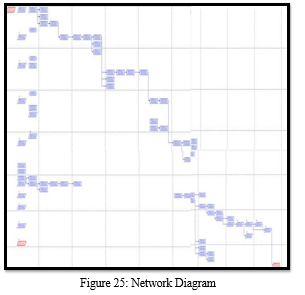
B. Work Breakdown Structure
By creating the WBS (Work Break down Structure) and allocating the resources the total duration of the project is calculated by planning and scheduling the project. In this study, the planned date of starting of project was 10/06/2022 and scheduled completion date is 12/04/2022.
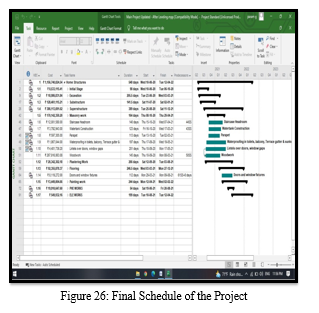
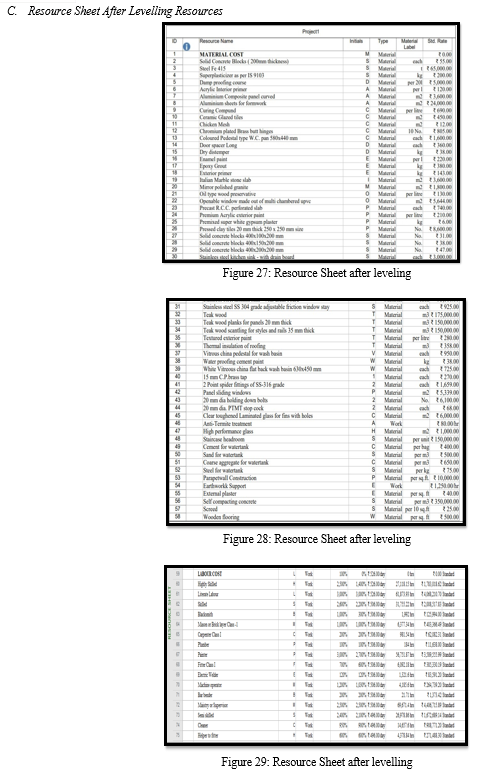
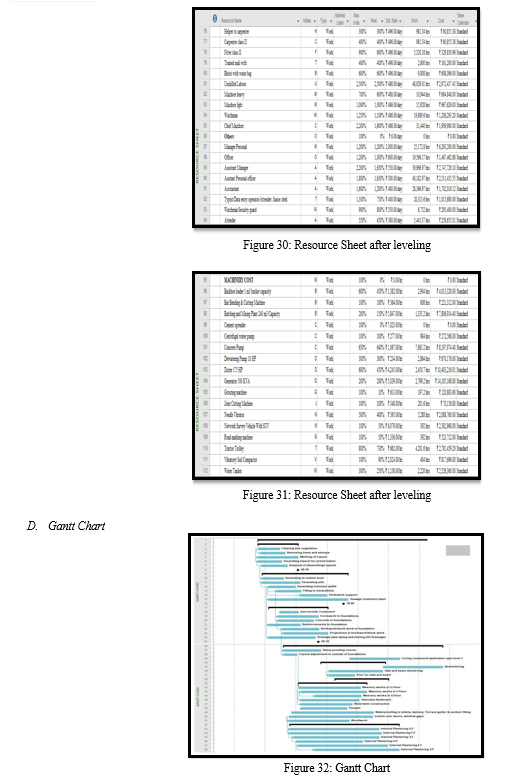
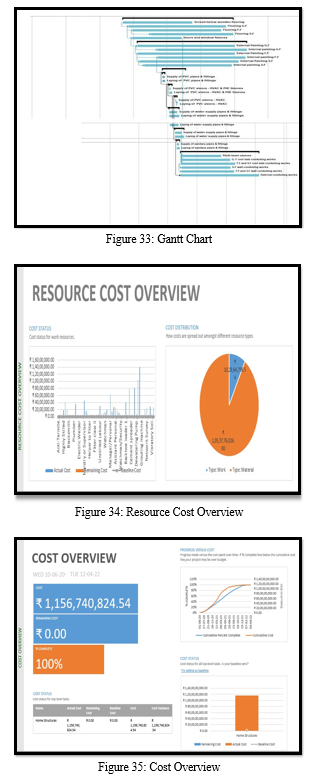
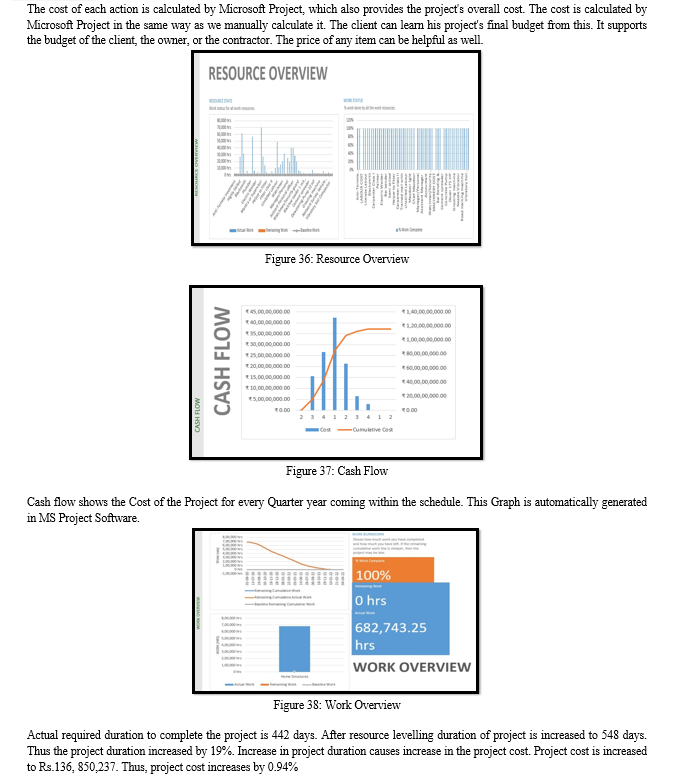
Conclusion
1) Construction management application, Microsoft Project 2013 is utilised in this project for planning, scheduling, resource allocation, levelling, and tracking. 2) Resources such as manpower, material and machinery are allocated for each and every activity according to the requirement. The overallocated resources are Assisstant Personal Officer, Painter, Tractor Trolley, Supervisor, Machine Operator, Manager Personal, Unskilled labour, Maistry/Supervisor, Mason, Lietrate Labour 3) Resource levelling is done for resource constrained analysis. Only labour and machinery are considered resources for this project. In exchange for lessening resource restrictions, duration is extended. 4) Actual required duration to complete the project is 442 days. After resource levelling duration of project is increased to 548 days. Thus the project duration increased by 19.3%. 5) Increase in project duration causes increase in the project cost. Project cost is increased to Rs.136, 850,237. Thus, the project cost increases by 0.001% without slack. Since there are 26 Villas, the cost of each villa would be around 4.5Cr. 6) Different graphical representations like charts, views are used to analyze the project as they are easy to understand. 7) This system of analysis can be used by a company with numerous projects that are comparable to update the best options according to the requirements. 8) This comprehensive study is conducted to develop a project timetable and identify the best way to employ all available resources. Additionally, it will support the funding needed for it as well as the procurement of materials.
References
[1] Rhuta Joshi, Prof. V. Z. Patil(2013), Resource Scheduling of Construction Project: Case Study, International Journal of Science and Research (IJSR) ISSN (Online): 2319-7064, Volume 4 Issue 5, May 2015 [2] Lokendra Magendra, Sudhanshu Pathak, (2016) Resource Leveling for a Residential Building: A Case Study, International Journal of Research in Civil Engineering, Architecture & Design Volume-4, Issue-2, April-June, 2016, www.iaster.com ISSN (O) 2347-2855 (P) 2347-828. [3] Rajani Vasant Kulgude, Prof. Amey A.Kelkar, (2018), Planning, Scheduling And Resource Management For A Multistoried Building Using Microsoft Project, International Research Journal of Engineering and Technology (IRJET) e-ISSN: 2395-0056 Volume: 05 Issue: 06 | June-2018 www.irjet.net p-ISSN: 2395-0072 [4] Lavanya S, G Narayana 2019, Cost Analysis of Construction Building By Earned Value Method using MS Project Software, International Journal of Recent Technology and Engineering (IJRTE) ISSN: 2277-3878, Volume-8, Issue-1C, May 2019 [5] Aldrin(2021) Planning and scheduling for multi-story building using M.S project, International Journal of Advance Research, Ideas and Innovations in Technology, ISSN: 2454-132X Impact Factor: 6.078 (Volume 7, Issue 2 - V7I2-1371) [6] T.Subramani, T.M.Karthick(2018), Study on Time and Resource Management in Construction Projects Using MS Project, International Journal of Engineering & Technology, 7 (3.10) (2018) 23-26 [7] Pooja Tripathi, Vinay Kumar Singh , Pravin Singh Tomar , J. P. Gupta, (2018), Planning And Scheduling Of Multistorey Rcc Building Using Microsoft Project, International Journal of Engineering Science Invention Research & Development; Vol. IV, Issue XI, MAY 2018 www.ijesird.com, E-ISSN: 2349-6185 [8] Sachin Pashupatihal, Prof. Vidyasagar V. Moogi(2019), Planning and Scheduling for a Multi-Storied Building using MS-Project , International Research Journal of Engineering and Technology (IRJET) e-ISSN: 2395-0056 Volume: 06 Issue: 07 | July 2019 www.irjet.net p-ISSN: 2395-0072 [9] Mr. Pradeep, Dr. Rajendra S, (2015), Planning, Scheduling and Resource Optimization for A Villa by using Ms-Project 2010, IJSRD - International Journal for Scientific Research & Development| Vol. 3, Issue 10, 2015 | ISSN (online): 2321-0613 [10] Roopa M (Ph.D.), Dr. T V Mallesh, Rahul Guna Vyjayanth, Geetanjali Lukram(2019), Study On Project Planning, Scheduling And Execution Of Residential Apartment Using Msp, International Journal of Scientific Development and Research (IJSDR) www.ijsdr.org, Volume 4, Issue 5 [11] Ms. Darshana P. Khandarea, Dr. M.R. Nagare, (2021) Prepare Project Schedule using Microsoft Project, International Journal of Research Publication and Reviews Journal homepage: www.ijrpr.com ISSN 2582-7421, Vol (2) Issue (8) (2021) 233-245 [12] Shruti Singh, Shweta Istape, Amruta Surve, Sahil Pandey, Avinash Singh, Sangram More, (2018) Comparative Study Of Planning And Scheduling Of A Construction Project Using Microsoft Project, IJRET: International Journal of Research in Engineering and Technology eISSN: 2319-1163 | pISSN: 2321-7308, Volume: 07 Issue: 06. [13] Akshayakumar V. Hanagodimath, Dr. H. M. Rajashekarswamy, Harshad R. Parate, Project Performance In Real Time Construction Industry - A Case Study, International Journal of Civil Engineering and Technology (IJCIET) Volume 7, Issue 5 [14] Abhishek Sharma and K.K. Pathak (2015), Manpower Planning, Scheduling and Tracking of a Construction Project Using Microsoft Project Software, National Institute of Technical Teachers’ Training and Research, Bhopal (M.P.), India [15] Common Schedule Of Rates For Engineering Departments 2021 - 2022 Public Works Department Government Of Karnataka Volume – 1 [16] Common Schedule Of Rates For Engineering Departments 2021 - 2022 Public Works Department Government Of Karnataka Volume - 2
Copyright
Copyright © 2022 Prajna Ganesh Gunaga, Geena George. This is an open access article distributed under the Creative Commons Attribution License, which permits unrestricted use, distribution, and reproduction in any medium, provided the original work is properly cited.

Download Paper
Paper Id : IJRASET46885
Publish Date : 2022-09-25
ISSN : 2321-9653
Publisher Name : IJRASET
DOI Link : Click Here
 Submit Paper Online
Submit Paper Online

